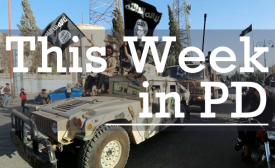middle east

This week in PD, the world witnessed the propaganda of violent extremist groups, including the Islamic State.
Anyone with a brain or a heart cannot help but be deeply disturbed by the unending and seemingly accelerating torrent of grim -- sometimes horrifying -- stories emanating from the Middle East. This week's gruesome, heartbreaking news of the beheading of American photojournalist James Foley is shocking evidence to this effect.
The Islamic State’s “A Message to America,” showing American journalist James Foley’s final moments, is vile and horrifying. Significantly, unlike the early propaganda of Al Qaeda, this video is also professionally cut and edited. It is the sort of thing engineered to achieve rapid, viral spread on the open internet. It also represents the main weapon the Islamic State is increasingly employing to great effect against the West.
Dear Iranian Negotiators: Some of you may remember me from the time I served on the American delegation to the nuclear talks. Although I left the U.S. Government over a year ago, I try to follow the negotiations closely, and I have been impressed by the determination and professionalism that you – as well as the Americans and indeed all the parties – have brought to the table.
Every week residents in the town of Kafranbel in Idlib, north west Syria, release a photo or sign related to current events in an attempt to draw the world’s attention to the ongoing civil war in their country.
In addition to pictures of mass executions and beheading videos, the Islamic State also puts out propaganda magazines containing stories about stoning adulterers and joining the jihad — all wrapped in a package with high production values.
Some Turkish journalists' unions have harshly criticized the beheading of US journalist James Foley, who had been missing since 2012, by the “Islamic State” (IS) on Tuesday and expressed concern for the Turkish citizens who have been held captive by the terrorist organization since June.
The Islamic State of Iraq and Syria (ISIS) militant group that has seized large parts of Iraq and drawn the first American air strikes since the end of the occupation in 2011 has warned the United States it will attack Americans “in any place” if the raids hit its militants.







